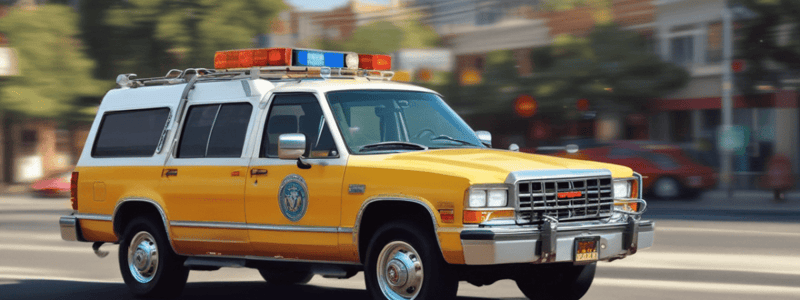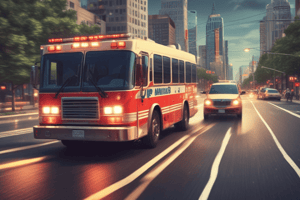Podcast
Questions and Answers
What should you do when driving on unpaved roads in rural settings?
What should you do when driving on unpaved roads in rural settings?
- Operate at a lower speed and keep a better grip on the steering wheel (correct)
- Increase your speed to maintain control
- Use your audible devices to alert other drivers
- Drive onto unpaved or grassy areas even if the ground has been saturated with rain
What should you do when approaching a school bus that has stopped to load or unload children?
What should you do when approaching a school bus that has stopped to load or unload children?
- Use your sirens to alert the children
- Speed up to avoid delays
- Stop the vehicle and wait for the operator to give permission to proceed (correct)
- Pass the school bus slowly
What should you do when driving through school zones?
What should you do when driving through school zones?
- Stop and wait for permission to proceed
- Use your lights and sirens to alert children
- Exceed the speed limit to respond quickly to emergencies
- Proceed through the school zone at the posted speed limit (correct)
What should you do when encountering a funeral procession?
What should you do when encountering a funeral procession?
What is the primary concern when driving around school buses?
What is the primary concern when driving around school buses?
What is a key consideration for emergency vehicle drivers when using warning lights and sirens?
What is a key consideration for emergency vehicle drivers when using warning lights and sirens?
What is a common source of lawsuits against EMS personnel and their services?
What is a common source of lawsuits against EMS personnel and their services?
When can emergency vehicle drivers proceed through a red light or stop sign?
When can emergency vehicle drivers proceed through a red light or stop sign?
What is a key consideration when using escorts?
What is a key consideration when using escorts?
What is a privilege granted to emergency vehicle drivers when using warning lights and sirens?
What is a privilege granted to emergency vehicle drivers when using warning lights and sirens?
When should emergency vehicle drivers use warning lights and sirens?
When should emergency vehicle drivers use warning lights and sirens?
What is a safety precaution when approaching intersections with warning lights and sirens?
What is a safety precaution when approaching intersections with warning lights and sirens?
What is a common mistake made by emergency vehicle drivers when using warning lights and sirens?
What is a common mistake made by emergency vehicle drivers when using warning lights and sirens?
Flashcards are hidden until you start studying
Study Notes
Emergency Vehicle Traveling Laws and Regulations
- Laws and regulations for emergency vehicle traveling vary from state to state and even city to city.
- Emergency vehicle drivers have certain limited privileges, but these privileges do not lessen liability in a crash.
Privileges and Liability
- If a crash occurs while the vehicle is operating with warning lights and sirens, the driver is presumed to be liable.
- Crashes involving emergency vehicles operating with warning lights and sirens are one of the largest sources of lawsuits against EMS personnel and their services.
Use of Warning Lights and Sirens
- The use of warning lights and sirens allows EMS drivers to:
- Park or stand in an otherwise illegal location
- Proceed through a red light or stop sign after stopping
- Drive faster than the posted speed limit
- Drive against the flow of traffic on a one-way street
- Make an illegal turn and travel left of the center to make an illegal pass
- The right-of-way privileges vary from state to state and should only be used when absolutely necessary.
Safe Use of Warning Lights and Sirens
- When using warning lights and sirens, the unit must be on a true emergency call.
- Both audible and visual warning devices must be used simultaneously when taking exemption to traffic laws.
- The unit must be operated with due regard for the safety of all others around us.
- The siren is often overused and should not be assumed to allow drivers to drive through congested areas without stopping or slowing down.
Safety Precautions
- When using escorts, leave enough space between vehicles to react to unexpected movements.
- Use a different siren tone than the first vehicle to alert motorists that a second vehicle is approaching.
- Instruct family members to not drive closely behind the emergency vehicle and to know how to get to the hospital at a slower speed.
- When approaching intersections, look for other motorists and pedestrians before proceeding.
- When traveling on unpaved roads in rural settings, operate at a lower speed and keep a better grip on the steering wheel.
- Avoid driving onto unpaved or grassy areas when the ground has been saturated with rain.
Special Considerations
- When traveling around school buses, never pass a school bus that has stopped to load or unload children or that has its stop arm extended.
- Stop the vehicle before reaching the bus and wait for the operator to give permission to proceed.
- When approaching school zones, be cautious not to attract children to the roadway with lights and sirens.
- In many states, it is not legal for an emergency vehicle to exceed the speed limit in school zones.
- Proceed through school zones at the posted speed limit.
- When encountering funeral processions, turn off audible devices out of respect, but be aware that there is no exemption for these processions.
Emergency Vehicle Traveling Laws and Regulations
- Laws and regulations for emergency vehicle traveling vary by state and city.
Privileges and Liability
- Limited privileges for emergency vehicle drivers do not lessen liability in a crash.
- Crash liability is presumed if a crash occurs while operating with warning lights and sirens.
- Crashes involving emergency vehicles are a significant source of lawsuits against EMS personnel and services.
Use of Warning Lights and Sirens
- Warning lights and sirens allow drivers to:
- Park or stand in illegal locations
- Proceed through red lights or stop signs after stopping
- Exceed posted speed limits
- Drive against traffic on one-way streets
- Make illegal turns and pass on the left
- Right-of-way privileges vary by state and should only be used when necessary.
Safe Use of Warning Lights and Sirens
- Units must be on a true emergency call when using warning lights and sirens.
- Both audible and visual warning devices must be used simultaneously when taking exemption to traffic laws.
- Units must be operated with due regard for the safety of others.
- Sirens should not be overused and do not guarantee safe passage through congested areas.
Safety Precautions
- Leave space between vehicles when using escorts to react to unexpected movements.
- Use a different siren tone than the first vehicle to alert motorists.
- Instruct family members to maintain a safe distance and know alternative hospital routes.
- Look for other motorists and pedestrians before proceeding at intersections.
- Operate at lower speeds on unpaved roads in rural settings and maintain a firm grip on the steering wheel.
- Avoid driving on unpaved or grassy areas when the ground is saturated with rain.
Special Considerations
- Never pass a stopped school bus loading or unloading children or with its stop arm extended.
- Stop before reaching the bus and wait for permission to proceed.
- Be cautious not to attract children to the roadway with lights and sirens in school zones.
- In many states, emergency vehicles cannot exceed the speed limit in school zones.
- Proceed through school zones at the posted speed limit.
- Turn off audible devices when encountering funeral processions, but be aware of no exemptions.
Studying That Suits You
Use AI to generate personalized quizzes and flashcards to suit your learning preferences.




